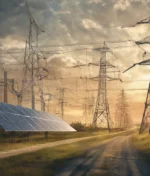
How Modern Grid Capacity Solutions Can Transform Your Smallworld Implementation
Unlocking Grid Capacity: Insights from GE Vernova’s White Paper on Digital Dynamic Line Rating
In the rapidly evolving landscape of energy transmission, utilities face mounting pressures to maximize grid capacity while navigating regulatory, economic, and environmental challenges. Today, we turn our attention to a compelling white paper from GE Vernova titled Unlock Transmission Capacity: GridOS® Digital Dynamic Line Rating. This document provides a thorough examination of the obstacles confronting transmission utilities and introduces a software-based solution designed to address them efficiently. As a platform dedicated to innovative developments in technology and sustainability, MagikDev highlights this resource to inform our readers about advancements in grid orchestration.
GE Vernova’s white paper outlines the critical need for enhanced transmission capacity amid the global energy transition. It emphasizes how traditional methods, such as building new infrastructure or deploying hardware sensors, are increasingly inadequate due to their high costs, lengthy timelines, and limited scalability. Instead, the paper advocates for Dynamic Line Rating (DLR) technology, which adjusts line ratings in real time based on environmental factors like temperature, wind, and irradiance.
Here are some key highlights from the white paper:
- Rising Challenges in Grid Management: The document details factors straining transmission grids, including skyrocketing power demand driven by data centers (e.g., projections of 3.5GW additional load in the San Francisco Bay area by 2029), market congestion costing billions annually, interconnection delays for renewables (with over 2,000GW of projects in limbo in the U.S. as of 2022), and regulatory hurdles exemplified by projects like Arizona’s SunZia Wind and Transmission, delayed for 17 years.
- The Role of Dynamic Line Rating (DLR): DLR enables utilities to optimize existing infrastructure by calculating ratings dynamically rather than relying on conservative, static assumptions. GE Vernova’s GridOS Digital Dynamic Line Rating (DDLR) offers a software-centric approach, using high-resolution weather models to eliminate the need for physical sensors, which can cost up to $12,500 per mile including maintenance.
- Operational Modes and Benefits: DDLR operates in two modes—Ambient Adjusted Rating (AAR) for compliance with regulations like FERC Order 881, and full DLR mode, which incorporates wind and irradiance for more precise calculations. This can increase line capacity by up to 33% compared to seasonal ratings. Additional advantages include investment reductions of up to 250 times versus sensor-based solutions, improved reliability, reduced congestion, faster renewables integration, and streamlined FERC 881 compliance through automated hourly ratings and forecasts.
- Real-World Applications: The white paper shares case studies, such as a Midwestern U.S. utility simplifying compliance across MISO and SPP markets, and Pacific Gas and Electric (PG&E) optimizing capacity amid load growth from electrification and data centers.
- Broader Implications: By leveraging the GridOS platform, DDLR supports modular, secure deployments (cloud or on-premises) and integrates with tools like the Limit Exchange Portal for market visibility. It positions utilities to defer costly expansions, enhance grid resilience against severe weather, and contribute to a more sustainable energy ecosystem.
This white paper underscores GE Vernova’s expertise in grid software solutions, quoting industry insights from IDC Energy Insights on DLR’s potential to revolutionize power transmission efficiency. For professionals in energy, technology, or sustainability sectors, it offers valuable data and strategic considerations without endorsing hardware-heavy alternatives.
To explore the full details, including technical diagrams, cost analyses, and expert commentary, we recommend reviewing the complete GE Vernova white paper available for download [here](White Paper GE Vernova.pdf). This resource is an essential read for understanding how digital innovations can orchestrate a more resilient and efficient energy grid.
Read the full GE Vernova white paper for complete technical details and case studies




